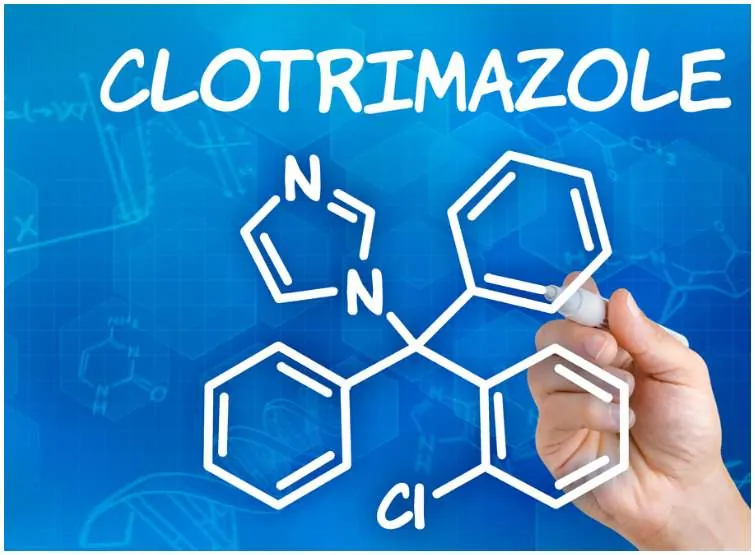Comparison Butenafine Hydrochloride vs Clotrimazole:
Introduction
Jock itch, also called tinea cruris, is a contagious skin infection caused by a type of fungus called dermatophytes (they are the most widespread superficial fungal infections among human beings).
Jock itch can spread from another person, either via sharing items (like – towels or clothing) or direct contact.
Common symptoms include:
- scaly, red, or brown patches;
- cracked or flaking skin;
- burning sensation around the affected area;
- persistently itchy skin in the groin area;
- a red rash with raised edges – typically on the groin, inner thighs, skin folds, or buttocks.
Ringworm, also known as tinea corporis, is a fungal infection that is caused by a fungus that can live on the skin, household items (like towels), surfaces (such as locker room floors), and clothes.
Children under 15 are especially susceptible to this infection.
Tinea corporis can appear on just about any part of the body.
Common symptoms include:
- hair loss in the affected area;
- a ring-shaped rash;
- red, scaly, or cracked skin;
- itchy skin.
Tinea corporis is highly contagious and can be spread from individual to individual, as well as from household pets or by clothing used by an affected individual.
Treatment
Over-the-counter antifungal sprays, creams, or powders may solve these problems.
Here is a comparison of two antifungals that can be used for the treatment of jock itch and ringworm:
Butenafine Hydrochloride
It is an antifungal medicine that fights infections caused by fungus.
It can be found under the brand names Lotrimin and Mentax.
This antifungal is a member of the family of antifungal compounds known as benzylamines, which are structurally similar to allylamines.
Clotrimazole
It is a crystalline, colorless, weakly alkaline anti-fungal medication that was discovered in 1969. It can be either taken orally or applied topically as an ointment to the skin.
Uses
Butenafine Hydrochloride
It is used for the treatment of tinea cruris (jock itch), tinea corporis (ringworm), and tinea pedis (athlete’s foot).
Clotrimazole
It was therapeutically effective, as confirmed by clinical improvement and mycological cure, in cutaneous candidiasis, tinea cruris, tinea pedis, pityriasis versicolor (cutaneous fungal infection), and tinea corporis.
Mechanism of Action
Both agents work by killing sensitive fungi by interfering with the formation of the fungal cell membrane.
Absorption through intact skin is minimal.
Side Effects
Butenafine Hydrochloride
The most common side effects associated with this antifungal include:
- burning or itching where the antifungal was applied;
- urticaria.
Rare side effects may include:
- severe blistering or irritation of treated skin;
- severe burning of the treated area.
Clotrimazole
Call your healthcare professional at once if you have a serious side effect such as:
- severe blistering of the treated skin;
- oozing;
- severe burning.
Common side effects include:
- urticaria;
- a burning sensation at the time of application;
- foul-smelling vaginal discharge;
- nausea;
- breathing difficulty;
- itching of the skin;
- stomach pain;
- tightness in the chest;
- vomiting.
Dosage
For tinea cruris and tinea corporis, apply butenafine hydrochloride once per day for 14 days to the affected area.
Apply clotrimazole to the affected and surrounding area twice per day. Discontinue its use if irritation or sensitivity occurs.
Warnings & Precautions
Butenafine Hydrochloride
Wash hands before and after use. This medicine is contraindicated in people who are hypersensitive to this antifungal. It is not for oral, ophthalmic, or intravaginal use.
Also, the safety of this medicine in children less than 12 years of age has not been established in clinical studies.
Clotrimazole
Wash your hands before and after using it.
This medicine should not be used if you are allergic to one or any of its active or inactive ingredients. Also, avoid getting this medicine in your mouth, nose, or eyes.
Drug Interactions
These agents may negatively interact with the following drugs:
- anisindione (a man-made anticoagulant and an indanedione derivative);
- dicumarol;
- carbamazepine;
- Jantoven (a medication that is used as an anticoagulant);
- Miradon (a synthetic anticoagulant);
- phenytoin (sold under the brand name Dilantin);
- clomipramine (a tricyclic antidepressant that is used for the treatment of obsessive-compulsive behavior);
- warfarin;
- Coumadin.
ALSO READ: Clotrimazole vs Miconazole
Alcohol
These antifungal agents are generally used topically, meaning that the medicine does not get absorbed into the body to a great extent.
Therefore, consuming alcohol is unlikely to interfere in a negative way with these medicines.
ALSO READ: Tioconazole vs Miconazole
Is It Safe During Pregnancy or Breastfeeding?
Butenafine Hydrochloride
Data are limited regarding the use of this antifungal during breastfeeding, and its excretion in breast milk is unknown.
But, the producer recommends caution when administering to lactating women.
Also, well-controlled studies in pregnant women have not been conducted. Talk with your doctor prior to use.
Clotrimazole
This medicine is not expected to harm a developing fetus.
Moreover, it is not known whether this antifungal agent passes into breast milk or if it could affect in a negative way the nursing baby.
It is recommended to tell your healthcare professional if you are breastfeeding a baby before starting treatment with this medicine.
ALSO READ: Pazeo vs Pataday
Conclusion: Butenafine Hydrochloride vs Clotrimazole – Which Is The Best OTC Antifungal Cream?
Butenafine hydrochloride (brand names – Lotrimin and Mentax) is an antifungal agent belonging to the class of benzylamine derivatives.
It is used for the treatment of jock itch, ringworm (tinea corporis), athlete’s foot, and other conditions. It works by stopping the growth of fungus by preventing them from making their protective covering.
Clotrimazole is an antimycotic drug that was synthesized by the Bayer Laboratories in Elberfeld, Germany.
This antifungal is used to treat athlete’s foot, ringworm (tinea cruris), vulvovaginal candidiasis, and jock itch. It is available as a topical solution, a spray, and as a cream.
In conclusion, both medicines are antifungals and have a similar mechanism of action. According to available data, butenafine hydrochloride has a slightly higher clinical and mycological cure as compared with clotrimazole.
Sources http://www.bioline.org.br/pdf?pr14169 http://aac.asm.org/content/45/12/3347.full.pdf http://arthritistrust.org/wp-content/DoubleBlindClotrimazoleStudyPlan.pdf https://onlinelibrary.wiley.com/doi/full/10.1046/j.1365-3156.1999.00396.x

